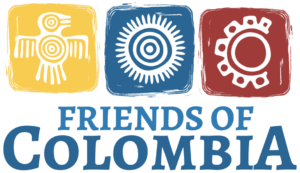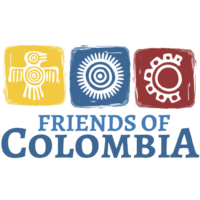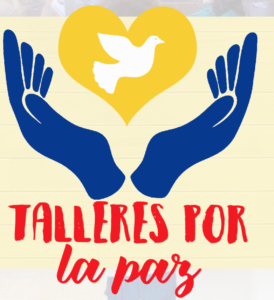By Maya Cross (CII-8, 2016-2019)
This project began because of a friendship between Maya, a young Peace Corps Volunteer and Katy, a dedicated Colombian mother. Their connection was based on a shared dream: a dream of a town in peace. A dream of a town where children would feel listened to and safe to be their authentic selves. A dream of a town where adults would value the unique talents of every child and empower them to become the leaders of the future. That dream was the basis of what would become, Talleres por la Paz. If Talleres Por la Paz was a tree, this dream would be the seed that started it all.
The first phase of the project was a training on the facilitation of groups of diverse people led by Eduardo de La Vega. Eduardo taught only with experiential education, an educational theory that engages participants fully in an experience, then allows them to reflect and learn through that experience, and then apply lessons learned to future situations. Many participants came to the training expecting to find a lecturer with a group quietly and diligently taking notes; instead they found a group of professional adults laughing and jumping around an auditorium while playing a game with a huge beach ball. Throughout the training, the diverse group of 25 teachers, government workers, student teachers, and community members learned about one another. They learned that despite their vast differences in age, gender, socioeconomic level, and position in society, that they were all good people living complicated lives. They had all suffered, faced challenges, done things to be proud of, and had dreams. With this cushion of empathy developed on the first day, the group moved on to more difficult challenges. They asked tough questions and discussed the most pressing issues of Manati. Not everyone always agreed with what the other was saying, but they all listened to each other. By the third day, they were ready to develop and practice their own activities to take back to the classroom or to use in the children’s workshops.
If Katy and Maya’s dream was the seed, then the first phase was the roots of the tree. The roots are the foundation of the tree, the part that digs deep and withstands any type of damage that is done to the parts above ground. Eduardo de la Vega’s training was what allowed the roots of hope, knowledge, and experience to take hold in the hearts and minds of the 25 diverse people who graduated from the first phase. No matter what happens with the project in the future, they will always have the roots. Just as a tree cannot grow without its roots, the project could not grow without the first phase.
In between the first phase and the second phase, the trunk of the tree began to grow. The project directors and student teachers held a meeting which allowed the student teachers to fulfill their role as the main developers and creators of the children’s workshop. By starting with the question, how do we want to change education? the student teachers decided on goals and objectives for the children’s workshop. They wanted a more empathetic education system and so one of the main goals of the workshop was for students to leave the workshop as more empathetic, tolerant, and respectful students. As a trunk is the principle vehicle to transfer the nutrients of the roots to the branches, the student teachers are the connectors that transfer the knowledge and experience in the roots to the children, the branches of the tree.
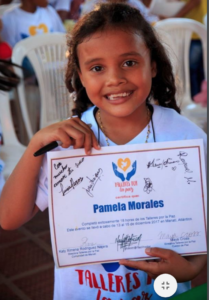
The second phase of the project was the children’s workshop. On the first day the student teachers facilitated a series of team building and relationship building activities with the participants. The kids’ favorite game was the popcorn machine, in which a team holds onto a parachute as balls “popcorn kernels” are thrown onto the parachute. The teams had to work together to make the popcorn kernels jump into the air and land back onto the parachute while more kernels were being thrown onto the parachute. On the second day, the student teachers facilitated a school wide scavenger hunt, in which teams had to use a map to find hidden puzzle pieces to complete a puzzle. During the activity, it was discovered that some teams were cheating by stealing other teams’ puzzle pieces, thus not allowing them to complete to puzzle. What was originally designed as a team building activity, was quickly turned into a valuable discussion with the kids about the repercussion of cheating in the real world. Due to the cheating, none of the teams were allowed to win and the kids experienced the disappointment of how one person’s dishonest actions can ruin the outcome for everyone. They were able to connect the cheating in the game to examples of cheating in the real world. One kid remarked, “It starts with stealing a puzzle piece and turns into a bank robbery.” After getting to know each other, by the third day they felt safe to talk about their lives with each other by creating and sharing a book of their life. The kids commented that they felt relief after sharing their stories with their peers. The student teachers were able to interact with the kids in an informal setting, allowing them to understand and empathize better with their future students. One student teacher commented that the activity helped him to understand that these kids have real problems that extend beyond a lost pencil or school assignment, and that he will be able to be a better teacher by learning about his students’ problems.
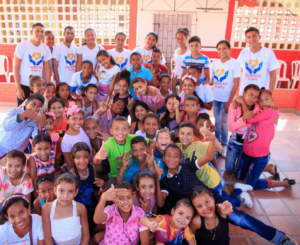
The branches are the newest part of the tree, the part that is growing the fastest. The branches hold the ultimate product; the leaf, the flower or the fruit. Through the children of the workshop, all the people involved could clearly see the fruits of their labor. All of the 45 children that attended Los Talleres por la Paz developed or practiced at least one new interpersonal skill. For the student teachers, the children’s workshop was an opportunity to grow as professional educators and gain experience. For the kids, the workshops were an opportunity to make friends with kids from other schools, build/encourage empathy, have fun and learn for 3 days during summer vacation.
With a total of 70 direct beneficiaries and hundreds of indirect beneficiaries, there is no limit to how deep the roots can go, how sturdy the trunk will be, how many branches will grow, and how many fruits this tree will produce. The tree of Talleres por la Paz can only be watered by the strength of the relationships with the different communities that support it. The support of an association of RPCVs in the States was just as fundamental as the support of the local school community in the overall outcome of the project. Maya and Katy were only able to turn their small seed into a tree by building and strengthening communities and the project will only succeed in the future if it continues to do just that.
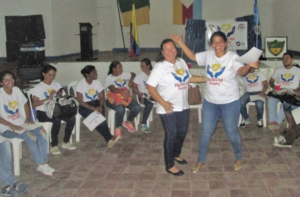
Goals achieved
Our main goal for Talleres por la Paz was to promote significant change in the way teachers conduct school and classroom activities, so that students effectively develop interpersonal skills that will enable them to better relate to their classmates and prevent instances of bullying or exclusion in the school context. By accomplishing the following three main project objectives the project directors feel confident that the project was a success.
1. At the end of the student workshop (phase two), 8 student teachers facilitated a total of 12 age-appropriate experiential learning activities that promoted one or all of the workshop principles among participants (empathy, conflict resolution, and teamwork).
2. At the end of the student workshop, 45 children between the ages of 7-13 developed interpersonal skills related to the workshop principles.
3. By the student workshop in December 2017, 8 student teachers applied at least two new strategies to collaboratively design activities based on experiential learning that was used to promote one or more of the workshop principles.
Total Beneficiaries: A total of 70 people from the ages of 7-60 and 4 organizations were direct beneficiaries of the project.

